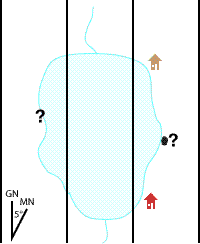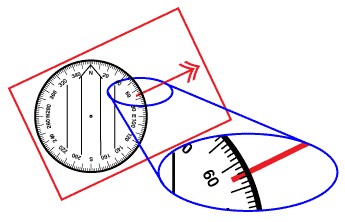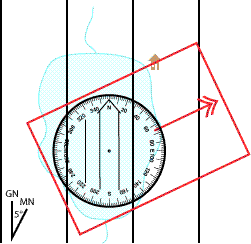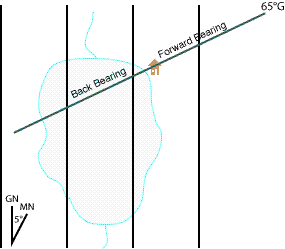Plotting a bearing on a map using a baseplate compass

Sighting the bearing
To determine our location we are going to combine two pieces of information on our map. We know that we are somewhere along the shoreline of the lake. Using a compass we can sight a bearing to our cabin across the lake. When we plot the bearing on our map, our location will be where the line between our location and the cabin crosses the shoreline of the lake.
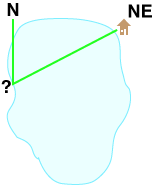
Determine a rough direction to the target
Use a compass to get a general sense of direction for North, South, East, and West. Identify on of the eight compass points (N, NE, E, SE, S, SW, W, NW) that roughly describes the direction to our sighting target. In our example at the lake, our cabin is NE of our current location. Refer back to this "reality check" occasionally during plotting to make sure what you are doing makes sense.
Sight the bearing to the target
Using our compass we have sighted a bearing to our cabin of 60° from Magnetic North. The north reference is an integral part of any bearing. Make sure you include it when you say or write a bearing. We can abbreviate to either 60° Mag. or just 60°M
Adjust the north reference to match the map
We want to plot our bearing onto the map relative to Grid North. Looking at the declination diagram on the map, we see that in this part of the north woods, Magnetic North is 5° east of Grid North. We will add 5° to our bearing to convert it from a Magnetic bearing to a True bearing.
If you don't already understand north references and converting between them, you should take a detour to our North Reference Tutorial.
Our bearing was taken from an unknown location, towards a known location. When we plot it on the map, we will start plotting at the known location, and extend the bearing line back towards the unknown location. This is known as a back bearing.
For more information on forward and back bearings, see our tutorial on forward and back bearings.
Step by step procedure for plotting with a baseplate compass
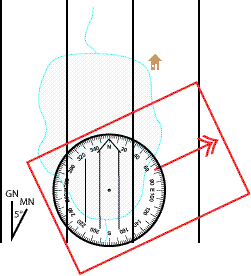
Additional techniques for plotting a bearing...
- Plotting a bearing using a protractor
- Plotting a bearing using a baseplate compass adjusted for declination
- Plotting a bearing using a straight edged lensatic compass
- Plotting a bearing using a round lensatic compass
Continue this tutorial on plotting a bearing with these links:
Plotting a second and third bearing to confirm your positionUsing bearings to locate a distant target
